PDF of this article (293 KB)
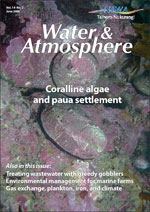
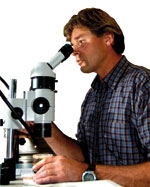
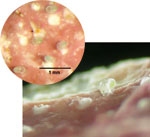
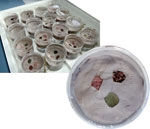
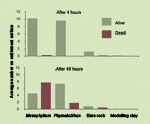
With many paua fisheries now heavily exploited, we are investigating ways to enhance the stock. Reyn Naylor, Kate Neill, and Rob Stewart are looking for environments that help baby paua get settled.
From the tropics to the polar regions, coralline algae are found throughout the world’s oceans. They can occur to depths of 270 m, but are especially abundant in shallow intertidal and subtidal environments, where they frequently cover the entire substrate. They can grow on a variety of surfaces, including rock, sponges, shellfish, and other algae. These encrusting (or crustose) corallines are red algae of the order Corallinales; unlike other red algae (including branching or turfing coralline algae) they are completely calcified. Until recently, very little was known about their taxonomy and distribution in New Zealand, as species identification is notoriously difficult. Their importance in marine ecosystems has long been recognised, however, and it is well known that they are one of the preferred settlement surfaces for paua, the New Zealand abalone (Haliotis iris).
Providing nurseries for paua
The early-settlement and post-settlement stages in paua are probably the least understood of all the physical and biological processes that determine their abundance in the wild. Mortality in these first few weeks of life is often extremely high.
Coralline algae produce chemicals which actively promote both settlement and early development in paua larvae. Research overseas and in New Zealand indicates that some alga species are more attractive to paua than others. There is also some evidence that post-settlement survival may vary on different species or growth forms of corallines, although the causes for this are unclear.
Looking in the lab
To investigate whether some corallines offer paua a better start in life, we conducted preliminary experiments on two species of coralline algae collected from Wellington’s south coast. The experiments were designed to examine the relative attractiveness of the algae with respect to settlement of paua larvae, as well as larval survival after settlement. The corallines we tested were Mesophyllum sp., which is relatively thick and often 'warty' looking, and Phymatolithon repandum, a thinner, smoother species. About seven days after fertilisation, paua larvae (from NIWA’s aquaculture facility at Mahanga Bay in Wellington) were introduced into small containers with three settlement choices: the two coralline algae and bare rock collected from the same waters. To ensure that potential settlement surfaces were about the same size and at the same height, the coralline crusts and pebbles were embedded into a layer of non-toxic modelling clay. We counted the newly settled paua at intervals of 4, 24, 48, and 72 hours.
The numbers of larvae settling and remaining on the two coralline surfaces were much higher than on either the control rocks or the modelling clay (see graph). Both species appeared equally attractive for larval settlement, but mortality was higher on Mesophyllum, resulting in significantly lower post-settlement survival. In an earlier experiment, mortality was signicantly lower overall, but was also higher on Mesophyllum than Phymatolithon.
And in the wild
We also made field observations to see whether there is a relationship between the abundance of juvenile paua (with shells about 30-70 mm across) and different species or growth forms of crustose coralline algae. During the day, paua smaller than about 70 mm are generally cryptic, hiding in crevices or under boulders, but at night they emerge to feed and are easily observed out in the open. Our night-diving observations on Wellington’s south coast indicated that for these small paua there was no clear preference for coralline algae. About 40% of the small paua we saw were on the surface of the smooth encrusting brown alga Ralfsia, 30% were seen on smooth coralline algae, such as Spongites, and another 25% were on bare rock. Less than 5% of the small paua were found on warty or turfing coralline algae. The influence of coralline algae on the growth and survival of young paua appears, therefore, to be more important in their very early stages of development.
Clue for re-seeding
The factors affecting the settlement and post-settlement survival of paua larvae are complex and interactive. Determining which coralline species induce high rates of settlement and survival may provide a useful indicator of the suitability of areas for re-seeding with larval paua.
Coming to terms with coralline algae
Coralline: resembles coral, especially in colour
Crustose: attaches to hard surfaces and covers like a crust
Turfing: spreads and forms thick dense mats
Further reading
Harvey, A.; Woelkerling, W.; Farr, T.; Neill, K.; Nelson, W. (2005). Coralline algae of central New Zealand: an identification guide to common 'crustose' species. NIWA Information Series No. 57. 145 p.
The authors all work for NIWA in Wellington. Reyn Naylor and Rob Stewart are involved in studies of benthic fisheries and ecology, and Kate Neill works in marine biodiversity and biosecurity. She is a co-author on NIWA’s guide to crustose coralline algae.
Teachers’ resource for NCEA AS: Biology 90161 (1.1), 90457 (2.1), 90460 (2.4), 90713 (3.1) 90716 (3.4). See other curriculum connections at www.niwa.co.nz/pubs/wa/resources
